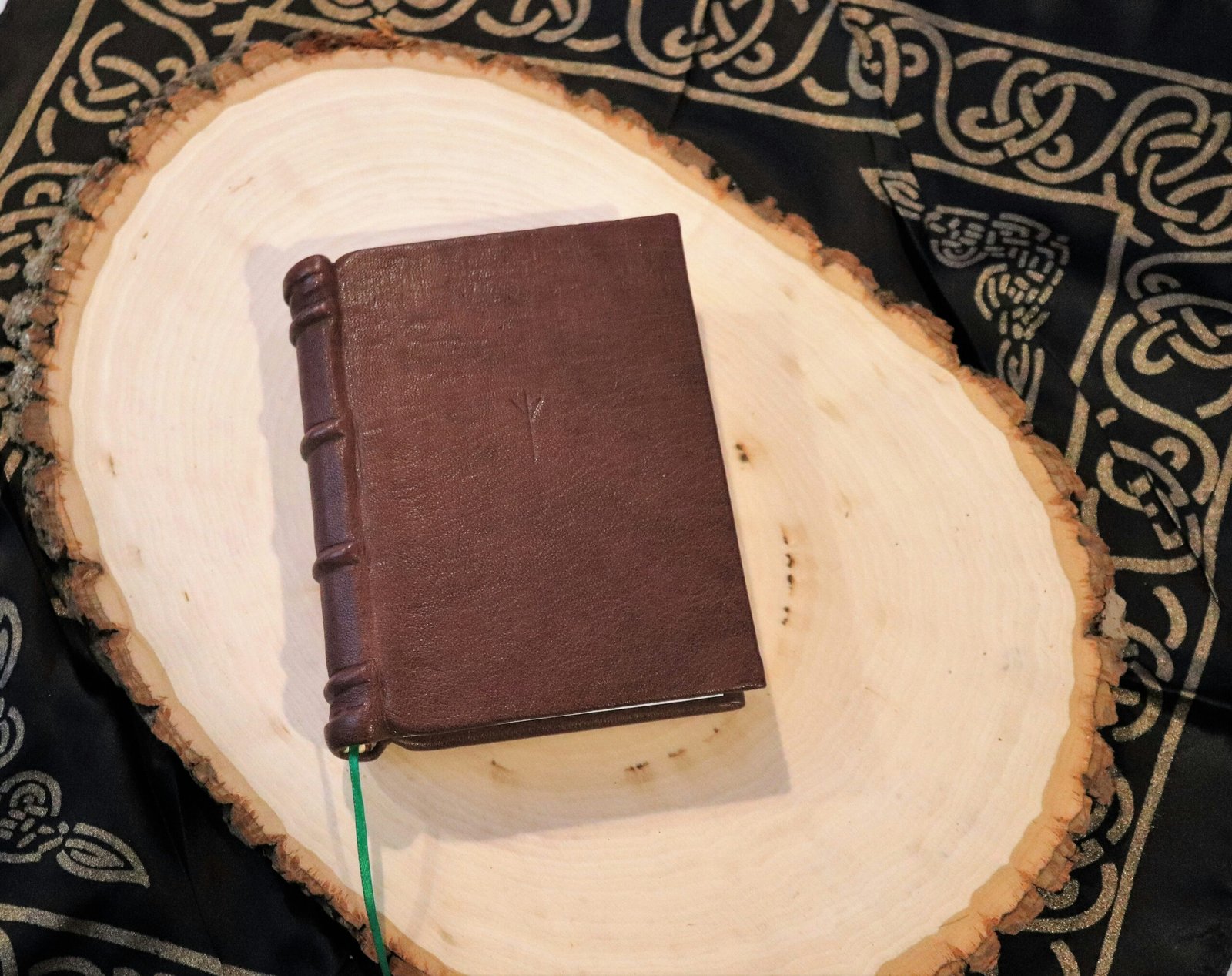Introduction to Magical Journaling
Magical journaling is a practice deeply interwoven with the art of spellcasting, serving as both a personal record and a reflective tool. This ancient tradition holds significant importance, as it allows practitioners to document their magical experiences meticulously. By maintaining a magical journal, one can enhance spiritual growth, gain clarity, and refine techniques through introspective analysis and continuous learning.
The practice of magical journaling dates back centuries and has been a cornerstone in various mystical traditions. From the grimoire-keeping of medieval magicians to the detailed records of modern-day Wiccans and occultists, the act of documenting one’s magical journey has proven indispensable. These historical accounts not only provide a wealth of knowledge but also illustrate the timeless significance of tracking one’s spiritual and magical endeavors.
One of the primary benefits of magical journaling is the enhancement of spiritual growth. By consistently documenting spells, rituals, and other magical activities, practitioners can observe patterns, recognize progress, and identify areas for improvement. This reflective practice fosters a deeper understanding of one’s spiritual path and cultivates a more profound connection with the mystical forces at play.
Furthermore, magical journaling offers clarity. In the midst of complex rituals and spellcasting, it is easy for details to become blurred or forgotten. A well-maintained journal serves as a reliable reference, capturing the nuances of each experience. This detailed documentation aids in recalling specific elements of spells, understanding their outcomes, and making informed adjustments for future practice.
Lastly, magical journaling helps refine techniques. By reviewing past entries, practitioners can evaluate the effectiveness of their methods, experiment with variations, and develop a more sophisticated approach to spellcasting. The iterative process of recording, analyzing, and refining not only hones one’s skills but also builds confidence in their magical abilities.
In essence, magical journaling is a vital practice for anyone engaged in spellcasting. It bridges the gap between historical traditions and contemporary practices, offering a structured way to document, reflect, and grow. By embracing this practice, one can navigate their magical journey with greater insight and efficacy.
Choosing the Right Journal
When embarking on a journey of magical journaling, selecting the right journal is a crucial first step. The type of journal you choose can significantly influence your spellcasting documentation experience. There are several formats to consider, each with its own set of advantages and unique features.
Physical notebooks are a traditional and popular choice for many practitioners. They offer a tangible connection to your work, allowing you to physically write out your thoughts and draw symbols or diagrams. The tactile experience of a physical notebook can enhance the meditative and reflective aspects of your practice. Options range from simple lined notebooks to elaborate, leather-bound journals adorned with mystical symbols. Choose one that resonates with your personal aesthetic and magical practice.
Digital journals are an increasingly viable option in today’s tech-savvy world. They offer the convenience of accessibility and organization. Apps designed specifically for journaling can provide features such as search functions, templates, and the ability to insert multimedia elements like images and audio recordings. This can be particularly useful for documenting complex rituals or spells that require detailed descriptions and visual aids. Moreover, digital journals are easily backed up, ensuring that your valuable insights and records are never lost.
Specialized magical journals are another excellent choice. These journals are specifically designed with the magical practitioner in mind, often including sections for moon phases, astrology charts, and spell logs. They may also provide prompts and guides to help structure your entries and ensure comprehensive documentation of your spellcasting activities.
Personalizing your journal is an essential aspect of making it a sacred space. Consider adding elements that reflect your personal practice, such as crystals, herbs, or sigils. You might also want to include a dedication page or a blessing to imbue your journal with your intentions. By decorating and customizing your journal, you create a space that is uniquely yours, enhancing the spiritual significance of your magical journaling journey.
Setting Up Your Magical Journal
Embarking on the journey of magical journaling begins with setting up a well-structured and organized journal. To ensure that your magical journal becomes a valuable tool in your spellcasting practice, it is essential to create a layout that facilitates easy navigation and efficient documentation.
The first step in setting up your magical journal is designing a table of contents. This will serve as a roadmap, allowing you to quickly locate specific entries. Begin by numbering the pages of your journal, then create a table of contents at the front. As you add new sections and entries, update this index to reflect where each section begins.
Next, consider creating distinct sections for different types of entries. Common sections include daily reflections, spell records, and dream logs. Daily reflections can capture your thoughts, feelings, and insights on a day-to-day basis. Spell records are crucial for documenting the details of your spellcasting activities, including the date, intention, materials used, and outcomes. Dream logs allow you to record and analyze your dreams, which can often provide valuable insights and guidance in your magical practice.
Incorporating magical symbols and correspondences within your journal can enhance its functionality and aesthetic appeal. Symbols such as pentagrams, moon phases, and runes can be used to decorate the pages, while correspondences related to elements, planets, and herbs can be included as reference guides. These elements not only personalize your journal but also serve as quick references when needed.
To maintain consistent journaling habits, start by setting aside dedicated time each day or week for journaling. Choose a time when you are least likely to be interrupted, allowing you to focus solely on your entries. Additionally, keep your journal and writing tools in a designated spot that is easily accessible. Consistency is key; even brief, regular entries can significantly enhance your magical practice.
By following these guidelines, you will create a magical journal that is not only well-organized but also an invaluable companion in your spellcasting journey.
Documenting Your Spellcasting
When embarking on the journey of magical journaling, it is essential to meticulously document each spellcasting activity. This practice not only helps in tracking progress but also in refining your craft over time. To begin, always note the date and time of your spell. These details can provide insights into the influence of lunar phases, planetary alignments, or even your personal energy levels at different times.
Next, clearly state the intention behind your spell. Whether it’s for protection, love, prosperity, or healing, a well-defined intention sets the focus and purpose of the ritual. This step is crucial as it aligns your energy and actions towards a specific goal.
Detailing the materials and ingredients used is another key aspect. List every item, from candles and crystals to herbs and oils. This comprehensive inventory can help you identify which components work best for you and allow for adjustments in future spellwork.
Document the steps of the ritual in a sequential manner. Describe each action, chant, or invocation performed. This not only serves as a reference for replication but also aids in evaluating the effectiveness of the ritual structure.
After completing the spell, take a moment to record any immediate impressions or outcomes. These could be physical sensations, emotional shifts, or even subtle signs from your environment. Such reflections can be invaluable for understanding the spell’s impact and for honing your intuitive abilities.
While thoroughness is important, strive to be concise. Use bullet points or short paragraphs to ensure that your documentation is clear and easily navigable. This balance between detail and brevity will make your magical journaling both effective and sustainable over the long term.
Reflecting on Your Magical Work
Reflection is a vital component of magical journaling, serving as a bridge between practice and understanding. By systematically reviewing and analyzing your entries, you can uncover valuable insights into your magical journey. Identifying patterns is one of the first steps in effective reflection. Look for recurring themes, symbols, or outcomes in your journal. These patterns can reveal the most effective techniques, helping you to refine and enhance your magical practice.
Recognizing successful techniques is equally important. By noting which spells or rituals yielded the desired results, you can build a repertoire of effective practices. Conversely, learning from failures is crucial for growth. Reflect on spells that did not work as intended. Consider what might have gone wrong and how you can adjust your approach in the future. This process of trial and error is fundamental to developing a robust and effective magical practice.
Tracking personal growth is another key aspect of reflection. Your magical journal not only documents your spells but also your evolution as a practitioner. Periodically review past entries to see how your understanding and skills have developed over time. This can be incredibly motivating and provide a sense of accomplishment.
To facilitate deeper reflection, consider incorporating specific questions and prompts into your journaling routine. Questions such as “What was the outcome of this spell?” “What emotions did I experience during the ritual?” and “What did I learn from this experience?” can guide your analysis. Prompts like “Describe a time when a spell exceeded your expectations” or “Write about a challenging magical experience and what you learned from it” can also encourage more profound introspection.
In summary, reflecting on your magical work through journaling is essential for continuous improvement. By identifying patterns, recognizing successful techniques, learning from failures, and tracking personal growth, you can gain deeper insights into your magical practice, ultimately enhancing your spellcasting journey.
Integrating other magical practices into your journaling can significantly enhance your spellcasting journey by providing a holistic view of your spiritual evolution. Documenting meditations, divination readings, dream work, and spiritual encounters allows you to create a comprehensive magical diary that reflects the multifaceted nature of your path.
Documenting Meditations
Recording your meditative experiences can offer deeper insights into your inner world. Note the date, time, and duration of each meditation session. Describe the focus of your meditation, any visualizations or mantras used, and the emotional or physical sensations you experienced. Reflect on any significant thoughts or revelations that arose and consider how these insights may inform your spellcasting practice.
Divination Readings
When documenting divination readings, such as tarot or oracle card pulls, include the date and the specific question or intention behind the reading. Record the cards drawn or symbols observed, and provide a detailed interpretation of their meanings. Highlight any patterns or recurring themes that emerge over multiple readings. This practice not only aids in understanding your divination tools but also in recognizing how these insights align with your magical work.
Dream Work
Dreams can be a rich source of magical information and guidance. Maintain a dream journal where you record your dreams immediately upon waking. Note the date, describe the dream in as much detail as possible, and include any emotions or sensations felt. Analyze the symbolism and consider how the dream’s messages might relate to your current magical practices or spellcasting goals. This ongoing record can reveal important subconscious patterns and spiritual guidance.
Encounters with Spiritual Beings
Encounters with spiritual beings, whether through meditation, ritual, or spontaneous experiences, should be meticulously documented. Record the date, time, and context of the encounter, along with a detailed description of the being and the interaction. Reflect on the messages or guidance received and how they resonate with your magical practice. Over time, these records can help you understand the nature of your spiritual relationships and how they influence your spellcasting.
By integrating these various aspects of your magical practice into your journal, you create a rich tapestry of your spiritual journey. This comprehensive approach not only enhances your spellcasting records but also provides a deeper understanding of your personal growth and transformation. Embrace the practice of magical journaling as a tool for reflection, growth, and deeper connection with your magical path.
Using Art and Creativity
Incorporating art and creativity into your magical journaling can significantly enhance your experience. By utilizing drawings, collages, calligraphy, and other forms of artistic expression, you can transform your journal into a vivid, personalized record of your spellcasting journey. This approach not only makes the process more enjoyable but also strengthens your connection to your magical work.
Visual elements such as drawings and illustrations can serve as powerful tools to capture the essence of your spells and rituals. For instance, sketching symbols or sigils associated with your spells can help you focus your intentions and visualize your desired outcomes. Additionally, creating collages from magazine cutouts, photographs, or other materials can provide a tangible representation of your goals and aspirations, further reinforcing your magical intentions.
Calligraphy, with its elegant and expressive strokes, can elevate the aesthetic appeal of your journal entries. Writing your spells, incantations, and reflections in beautiful script can imbue your words with a sense of reverence and significance. This practice not only enhances the visual appeal of your journal but also deepens your connection to the content, making each entry feel more meaningful and intentional.
Beyond these specific techniques, the act of engaging in creative expression can be deeply meditative and grounding. The process of drawing, painting, or crafting can help you enter a state of flow, where your mind is fully immersed in the present moment. This heightened state of awareness can lead to greater insights and a more profound understanding of your magical practice.
Ultimately, integrating art and creativity into your magical journaling allows you to create a journal that is uniquely yours. It becomes a living, evolving document that reflects your personal journey, capturing the intricacies of your spellcasting experiences in a way that words alone cannot. By embracing the power of visual elements, you can unlock new dimensions of understanding and connection within your magical practice.
Maintaining Privacy and Sacredness
Preserving the privacy and sanctity of your magical journal is paramount to ensuring the integrity of your spellcasting journey. A magical journal is a deeply personal artifact, often containing intimate details of one’s spiritual practices, reflections, and magical workings. To maintain its confidentiality, consider employing both physical and digital security measures.
For physical journals, select a secure location that is not easily accessible to others. A lockable drawer or a dedicated space within your personal altar can serve as ideal storage solutions. Additionally, using a journal with a lock or a protective cover can add an extra layer of security. When traveling, consider carrying your journal in a discreet, inconspicuous bag to avoid drawing unnecessary attention.
In the digital realm, utilize encrypted files and password-protected documents to safeguard your entries. Cloud storage services with robust security features can provide a reliable backup while ensuring that your journal remains accessible only to you. Regularly updating passwords and using two-factor authentication can further enhance the security of your digital journal.
Beyond physical and digital security, it is essential to treat your magical journal as a sacred object. This respect underscores the importance of your spiritual journey and reflects your commitment to personal growth. Handle your journal with care, perhaps incorporating a ritual of cleansing or blessing to imbue it with protective energies. This practice not only reinforces the sanctity of your journal but also deepens your connection to your magical work.
Ethical considerations are equally important when it comes to sharing the contents of your journal. While sharing insights with trusted individuals can foster a sense of community and mutual growth, it is crucial to set boundaries and respect your own privacy. Always obtain consent before sharing any entries that involve others, and be mindful of the potential impact of disclosing personal information.
In conclusion, maintaining the privacy and sacredness of your magical journal is a vital aspect of honoring your magical journey. By implementing practical security measures and treating your journal with reverence, you create a safe space for self-exploration and spiritual development. Respecting your own boundaries and those of others ensures that your magical practice remains a deeply personal and transformative experience.




